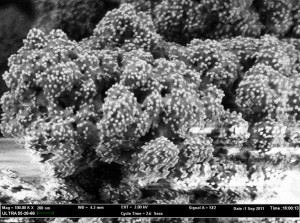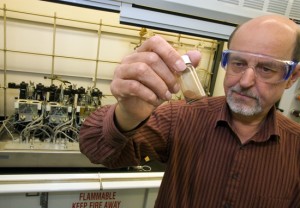
Adding gold nanoparticles to the surfaces of polymer monoliths opens new avenues to the functionalization and control of pore surface chemistry in chromatography.
For identifying and measuring the chemical constituents of a sample, or for purification purposes, one of the indispensable tools of chemistry is chromatography. By dissolving a sample into a fluid – called the “mobile phase” – and flushing it through a solid medium – called the “stationary phase” – chemists can separate the sample’s constituent chemical species – called analytes. Each individual analyte will be separated on the basis of how strongly it interacts with the stationary phase and how fast it diffuses through it.
One of the world’s foremost experts on chromatography is Frantisek Svec a chemist with Berkeley Lab’s Materials Sciences Division and director of the Organic and Macromolecular Synthesis facility at the Molecular Foundry, a DOE nanoscience center. Svec pioneered the polymer monolithic column, in which the polymer beads that typically fill the stationary phase column in a chromatograph are replaced with a single continuous piece of polymer that is perforated throughout with microscopic pores. This greatly accelerates the speed of the process, a critical factor, for example, when trying to determine the chemical constituents of a toxin or biological agent.
In a talk at the recent national meeting of the American Chemical Society (ACS) in New Orleans, Svec described how the speed and performance of chromatography can be even further improved with the addition of gold nanoparticles to the surface of the polymer monoliths. This makes chromatography exceptionally powerful for separating proteins and peptides, nature’s versions of nanomachines that serve as major workhorses for biology.
“By modifying the pore surface within our monoliths with gold nanoparticles we create a universal ligand that can be used to fish out thiol-containing proteins and peptides,” Svec said. “Similar processes involving thiol or other organosulfur-containing compounds also provide monoliths with a variety of interchangeable chemistries suitable for the chromatography of large biomolecules. The strong gold-thiol interaction also ensures the stability of the stationary phase.”
Svec said that using the thiol-exchange process, it should be possible to apply gold nanoparticles as a universal reversible intermediate ligand that would enable the surface chemistry of monoliths to be changed via the attachment of different thiol-containing compounds with desired functionalities.
“Modifying gold-containing monoliths with compounds bearing thiol groups opens new avenues to the functionalization and control of pore surface chemistry,” Svec said. “Gold nanoparticles represent a less common all-purpose intermediate ligand for the preparation of chromatographic columns, as well as for enzyme immobilization. Additional chromatographic mechanisms could also be realized through the combination of gold nanoparticles and chemical control of the porous properties of the monolithic support.”
Working on this research at the Molecular Foundry with Svec were Yongqin Lv, Zhixing Lin, Fernando Maya and Jiri Urban.
Additional Information
For more about the research of Frantisek Svec, visit his Website here
For more about the Molecular Foundry go here
